Nebraska is a state in the Midwest of the United States that is well known for its stunning rock formations and towering Sandhills. Based on paleontological research, Nebraska is famous for the diversity of its mammalian life during the Cenozoic Era, just after dinosaurs became extinct.
During the early Paleozoic, Nebraska was submerged in a shallow sea, home to creatures like trilobites, corals, and brachiopods. The sea withdrew during the early Cenozoic, providing the perfect environment for the first pint-sized, multiple-toed prehistoric camels, horses, rhinoceros, and other megafauna mammals to plod across the grassy plains of Nebraska.
8 Extinct Animals That Lived in Nebraska
Millions of years ago, Nebraska was home to numerous species of animals, which have been a significant subject of study among American vertebrate paleontologists. Below are the 8 extinct animals that once called Nebraska home.
1. Woolly Mammoth

The woolly mammoth thrived during the Pleistocene until becoming extinct in the Holocene epoch.
©Dotted Yeti/Shutterstock.com
| Woolly Mammoth | |
|---|---|
| Kingdom | Animalia |
| Phylum | Chordata |
| Class | Mammalia |
| Order | Proboscidea |
| Family | Elephantidae |
| Genus | Mammuthus |
| Species | Mammuthus primigenius |
| Living period | Between 800,000 years ago and 4,000 years ago |
Mammoths are the official state fossils of Nebraska. Along with mastodons, giant woolly mammoth fossils have been found in most counties in Nebraska. Not only did the woolly mammoth live in the state, but also the lesser-known Imperial mammoth and Columbian mammoth.
The woolly mammoth thrived during the Pleistocene until becoming extinct in the Holocene epoch. It was roughly the same size as modern-day elephants. Females weighed 8,000 pounds, while males weighed approximately 12,000 pounds. It’s thought that woolly mammoths became extinct due to a change in climate, precipitation regime, and widespread human hunting.
2. Arctodus
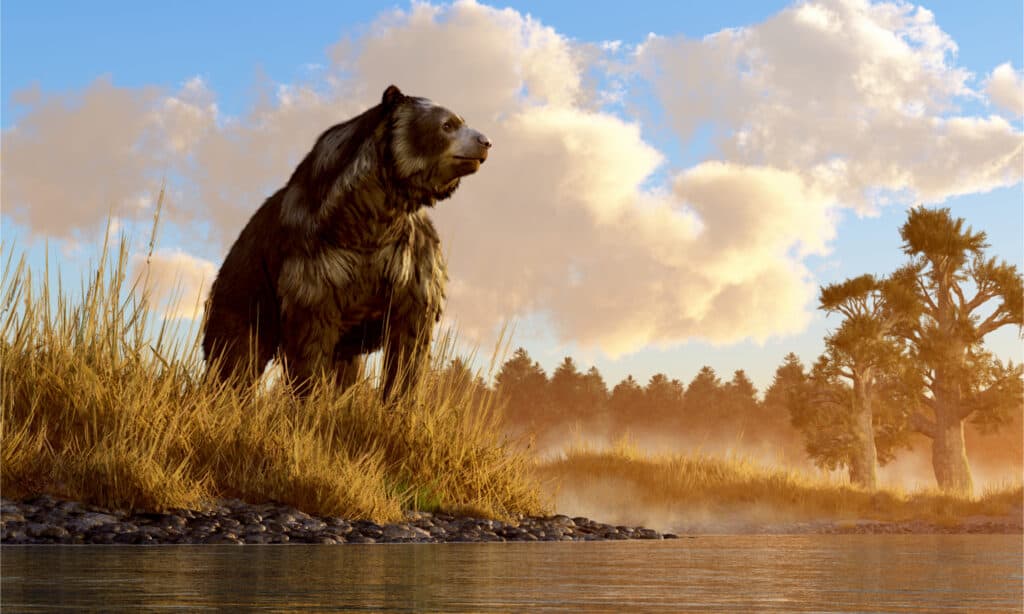
Arctodus is an extinct species of short-faced bear that lived in North America during the Pleistocene period.
©Daniel Eskridge/Shutterstock.com
| Arctodus | |
|---|---|
| Kingdom | Animalia |
| Phylum | Chordata |
| Class | Mammalia |
| Order | Carnivora |
| Family | Ursidae |
| Subfamily | Tremarctinae |
| Genus | Arctodus |
| Living period | From 2.5 million years to 12,000 years ago |
Arctodus is an extinct species of short-faced bear that lived in North America during the Pleistocene period. Paleontologists believe Arctodus was among the largest mammalian carnivorans that ever existed. These creatures were most widespread in North America and likely went extinct due to an ecological collapse that disrupted the vegetation and prey they relied on.
It’s estimated that Arctodus could grow up to 8-10 feet and weigh approximately 1,650 pounds, with the largest specimen recorded at 2,110 pounds. Compared to ursine bears, Arctodus’ paws were long, slender, and more elongated. Numerous Arctodus have been discovered throughout Nebraska.
3. Menoceras
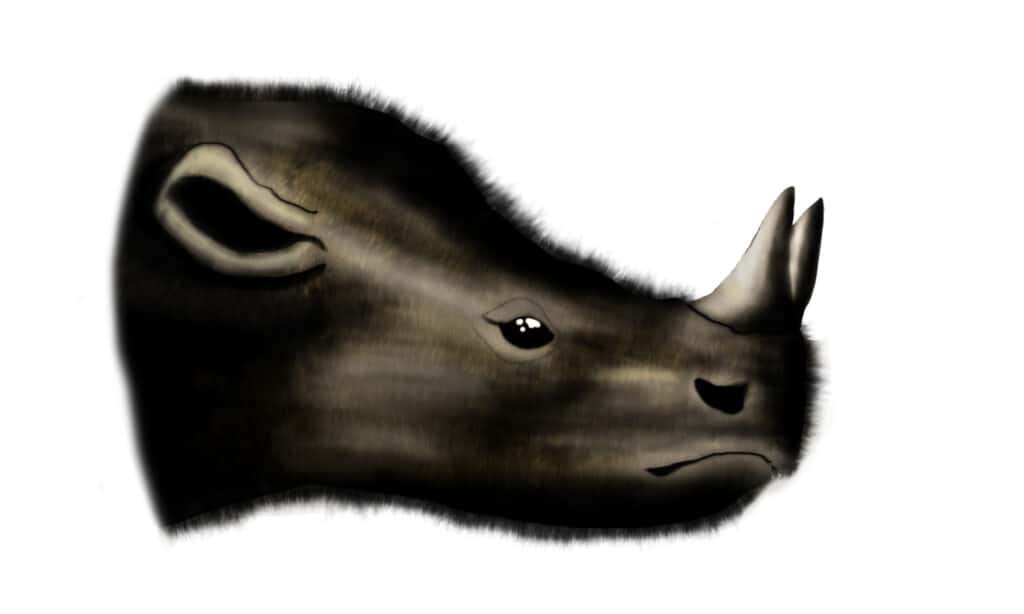
Female Menoceras were hornless, while males had two horns at the tip of their noses.
©Zero Smany/Shutterstock.com
| Menoceras | |
|---|---|
| Kingdom | Animalia |
| Phylum | Chordata |
| Class | Mammalia |
| Order | Perissodactyla |
| Family | Rhinocerotidae |
| Genus | Menoceras |
| Living period | About 30.7 million to 19.7 million years ago |
Menoceras is an extinct genus of small rhinoceros that lived in southern North America during the early Miocene epoch for approximately 11 million years. Female Menoceras were hornless, while males had two horns at the tip of their noses. This species grew to a length of 5 feet long.
A nearly complete skull of Menoceras was discovered in the Marsland Formation in Nebraska. It’s thought that Menoceras roamed across the vast plains of Nebraska about 30.7 million to 19.7 million years ago.
4. Teleoceras

Based on fossil analysis, it is thought that Teleoceras was a semi-aquatic animal, just like hippos.
©Ray Bouknight / CC BY 2.0 – License
| Teleoceras | |
|---|---|
| Kingdom | Animalia |
| Phylum | Chordata |
| Class | Mammalia |
| Order | Perissodactyla |
| Family | Rhinocerotidae |
| Subfamily | Aceratheriinae |
| Genus | Teleoceras |
| Living period | From about 17.5 million to 4.9 million years ago |
Teleoceras is another extinct genus of weird-looking rhinoceros that lived during the Miocene and Pliocene epochs. Unlike modern rhinos, Teleoceras had much shorter legs and a barrel chest, like a hippopotamus. It grew up to 13 feet long. Based on fossil analysis, it is thought that Teleoceras was a semiaquatic animal, just like hippos.
Teleoceras is one of Nebraska’s most common fossils in Ashfall Fossil Beds. Most of its remains have been preserved in a nearly complete state. Its remains are so numerous that the Ashfall Fossil Beds have been nicknamed the “Rhino Barn.” Teleocerus has also been featured in various films, including episodes of “Dawn of the Cats” and “Are Rhinos Dinos?” from the Paleoworld series.
5. Daeodon
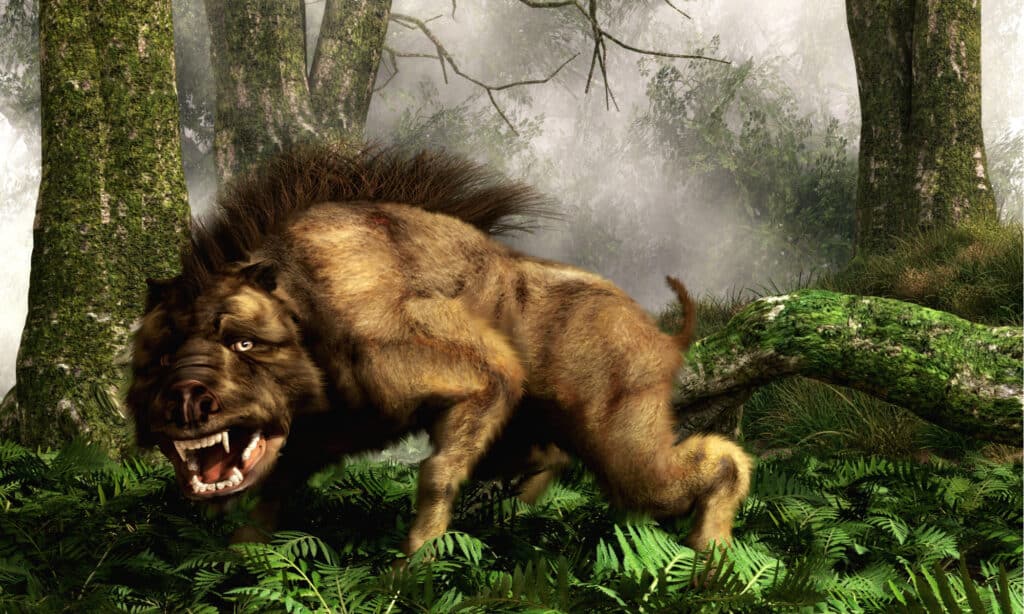
Based on fossil specimens, Daedons lived in dense forests and expansive prairies.
©Daniel Eskridge/Shutterstock.com
| Daeodon | |
|---|---|
| Kingdom | Animalia |
| Phylum | Chordata |
| Class | Mammalia |
| Order | Artiodactyla |
| Family | Entelodontidae |
| Genus | Daeodon |
| Living period | Thrived during the Miocene epoch, from about 23 million to 5 million years ago |
Daeodon is an extinct genus of entelodont that lived during the late Oligocene and the earliest Miocene. The name Daeodon was derived from the Greek words daios, meaning “dreadful” or “hostile,” and odon, meaning “teeth.” This creature measured about 5.8 feet tall at the shoulders and had a skull about 3 feet long. Its limbs were long and slender, and the foreleg bones were fused, with only two toes on each foot.
Based on fossil specimens, Daedons lived in dense forests and expansive prairies. Unlike other basal entelodonts like Archaeotherium, Daedons were more adapted to the grasslands. Their diet mainly consisted of vines, roots, nuts, meat, and bones. They were predominantly omnivores, a similarity they shared with all other entelodonts.
6. Palaeocastor
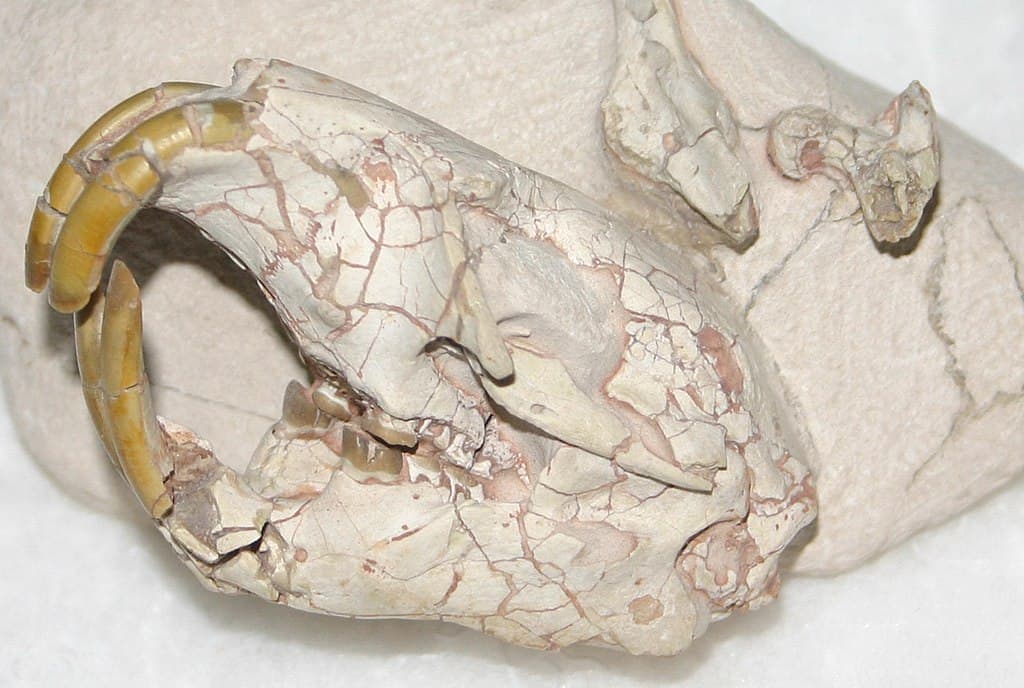
Palaeocastor is an extinct prehistoric beaver that lived during the late Oligocene to early Miocene periods.
©Kevin Walsh / CC BY 2.0 – License
| Palaeocastor | |
|---|---|
| Kingdom | Animalia |
| Phylum | Chordata |
| Class | Mammalia |
| Order | Rodentia |
| Family | Castoridae |
| Subfamily | Palaeocastorinae |
| Genus | Palaeocastor |
| Living period | From the late Oligocene period to the early Miocene |
Palaeocastor is an extinct prehistoric beaver that lived during the late Oligocene to early Miocene periods. It’s one of the strangest mammals to be discovered in Nebraska. Its basic form is an elongated spiral of hardened earth material. These puzzling structures were first found in Sioux County as tree-sized, screw-like underground formations.
Like many early castorids, Palaeocastors were predominantly burrowing animals who made corkscrew-shaped burrows and tunnels. Fossil evidence indicates that these creatures may have lived in groups like modern beavers.
7. Leptocyon

Leptocyon is a genus of extinct small-bodied, fox-like animals that first appeared in North America about 34 million years ago.
©Mariomassone / CC BY-SA 4.0 – License
| Leptocyon | |
|---|---|
| Kingdom | Animalia |
| Phylum | Chordata |
| Class | Mammalia |
| Order | Carnivora |
| Family | Canidae |
| Subfamily | Caninae |
| Genus | Leptocyon |
| Living period | First appeared about 34 million years ago during the Oligocene |
Leptocyon is a genus of extinct small-bodied, fox-like animals that first appeared in North America about 34 million years ago. They had narrow jaws and delicate teeth for snatching small, fast-moving prey. They shared standard features with the extinct Borophaginae group, with whom they appeared simultaneously. Unlike Leptocyon, Borophaginae’s skull and dentition were designed for a powerful killing bite.
Leptocyon specimens and other distant canine ancestors, including Aelurodon and Cynarctus, have been discovered in Nebraska. Prehistoric dogs roamed the state when it became terrestrial.
8. Miohippus
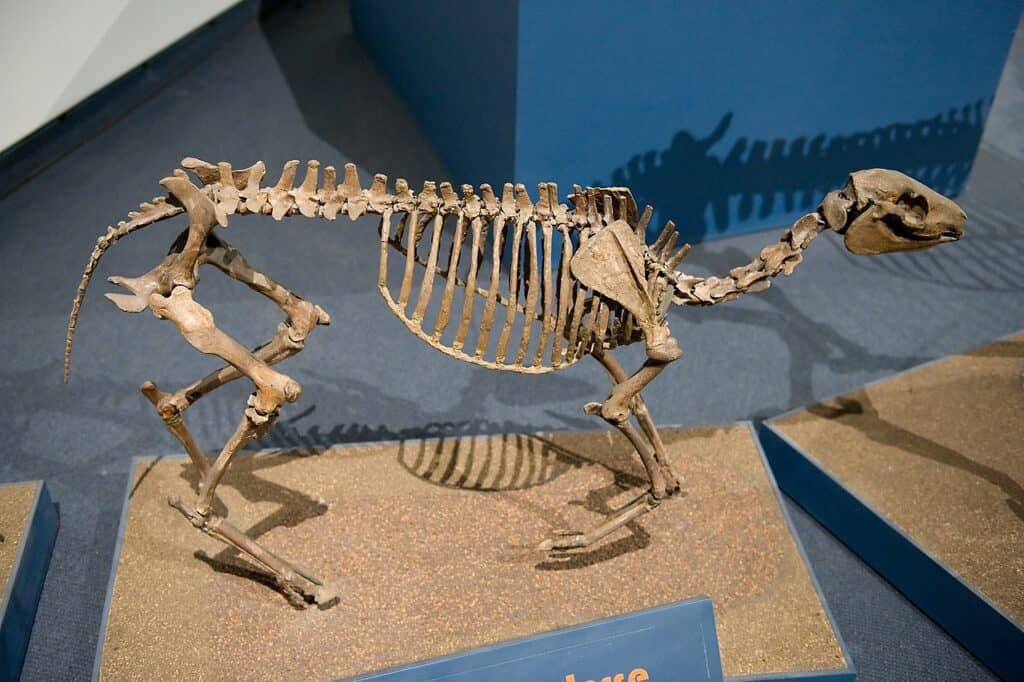
Miohippus means “miniature horse.”
©mark6mauno / CC BY-SA 2.0 – License
| Miohippus | |
|---|---|
| Kingdom | Animalia |
| Phylum | Chordata |
| Class | Mammalia |
| Order | Perissodactyla |
| Family | Equidae |
| Subfamily | Anchitheriinae |
| Genus | Miohippus |
| Living period | About 32 million to 25 million years ago |
Miohippus means “miniature horse.” It’s an extinct genus of prehistoric horses that lived during the Late Eocene to Late Oligocene. Miohippus species were slightly larger than earlier Eocene, but smaller than modern Equidae. They weighed approximately 88 to 121 pounds. They had a somewhat longer skull and an extra variable crest on their upper molars, giving them a more extensive surface area for chewing forage.
Specimens of Miohippus and other prehistoric horses, such as Pliohippus, Cormohipparion, and Neohipparion, have been discovered in Nebraska. According to paleontologists, prehistoric dogs preyed on them.
Summary of 8 Extinct Animals That Lived in Nebraska
Here’s a recap of 8 extinct animals that once inhabited the state of Nebraska:
| Number | Animal | Living Period |
|---|---|---|
| 1 | Woolly Mammoth | Between 800,000 years ago and 4,000 years ago |
| 2 | Arctodus | 2.5 million years to 12,000 years ago |
| 3 | Menoceras | About 30.7 million to 19.7 million years ago |
| 4 | Teleoceras | About 17.5 million to 4.9 million years ago |
| 5 | Daeodon | Miocene epoch: 23 million to 5 million years ago |
| 6 | Palaeocastor | Late Oligocene period to the early Miocene |
| 7 | Leptocyon | First appeared about 34 million years ago during the Oligocene |
| 8 | Miohippus | About 32 million to 25 million years ago |
The photo featured at the top of this post is © Warpaint/Shutterstock.com
Thank you for reading! Have some feedback for us? Contact the AZ Animals editorial team.






